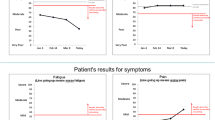Abstract
Objective. To determine the effect of illustrations on COOP Chart responses. Study Design. Randomized split-half design of 177 patients discharged from a medical centre during a 3 month interval. Patient responses were obtained. However, there are benefits from the use of illustrations. Further research measures. Demographic characteristics and health status. Results. No response differences were observed between patients who received COOP Chart illustrations and those who did not receive illustrations. Conclusion. Pictures do not appear to affect responses to COOP Charts. However there are benefits of the use of illustrations. Also, further research should be conducted with other patient populations and other COOP Charts before conclusive statements can be made regarding the use of illustrations with the COOP Charts.
Similar content being viewed by others
References
NelsonE, WassonJ, KirkJ, et al. Assessment of function in routine clinical practice: description of the COOP Chart method and preliminary findings. J Chronic Dis 1987; 40(1): 555–635.
NelsonEC, LandgrafJM, HaysRD, et al. The COOP function charts as practical measures of health status. In: LipkinM, ed. Functional Status Measurement in Primary Care. New York: Springer-Verlag, 1990: 97–131.
NelsonEC, LandgrafJM, HaysRD, WassonJH, KirkJW. The functional status of patients: how can it be measured in physicians' offices? Med Care 1990; 28: 1111–1126.
WassonJ, KellerA, RubensteinL, et al. Benefits and obstacles of health status assessment in ambulatory settings: the clinician's point of view. Med Care 1992; 30: MS42-MS49.
McHorneyCA, WareJE, RogersW, RaczeekAE, LuJFR. The validity and relative precision of MOS short- and long-form health status scales and Dartmouth COOP Charts: results from the Medical Outcomes Study 1992; 30; 5253–5265.
PoikolainenK, KarkkainenP. Nature of questionnaire options effects estimates of alcohol intake. J Stud Alcohol 1985; 46: 219–222.
SchwarzN, HipplerH, DeutschB, StrackF. Response scales: effects of category range on reported behaviour and comparative judgements. Public Opinion Quarterly 1985; 49: 388–395.
HaysRD, HubaGJ. Reliability and validity of drug use items differing in the nature of their response options. J Consult Clin Psychol 1988; 56: 470–472.
KaplanRM, DebonM, AndersonBF. Effects of number of rating scale points upon utilities in a Quality of Well-Being Scale. Med Care 1991; 29: 1061–1064.
ChernoffH. The use of faces to represent points in k-dimensional space graphically. J Am Stat Assoc 1973; 68: 361–368.
HadornDC, HaysRD, UebersaxJ, HaberT. Improving task comprehension in the measurement of health state preferences: a trial of informational cartoon figures and a paired-comparison task. J Clin Epidemiol 1992; 45: 233–243.
LandgrafJM, NelsonEC, HaysRD, WassonJH, KirkJ. Assessing function: does it really make a difference? A preliminary evaluation of the acceptability and utility of the COOP function charts. In: LipkinM, ed. Functional Status Measurement in Primary Care. New York: Springer-Verlag, 1990: 150–165.
McDowellI, NewellC. Measuring health: a guide to rating scales and questionnaires. New York: Oxford University Press, 1987.
Author information
Authors and Affiliations
Additional information
Supported in part by a grant from the Henry J. Kaiser Family Foundation (Nelson) and a contract from the World Health Organization, Regional Office for Europe (Hays).
Rights and permissions
About this article
Cite this article
Larson, C.O., Hays, R.D. & Nelson, E.C. Do the pictures influence scores on the Dartmouth COOP Charts?. Qual Life Res 1, 247–249 (1992). https://doi.org/10.1007/BF00435633
Received:
Accepted:
Issue Date:
DOI: https://doi.org/10.1007/BF00435633




